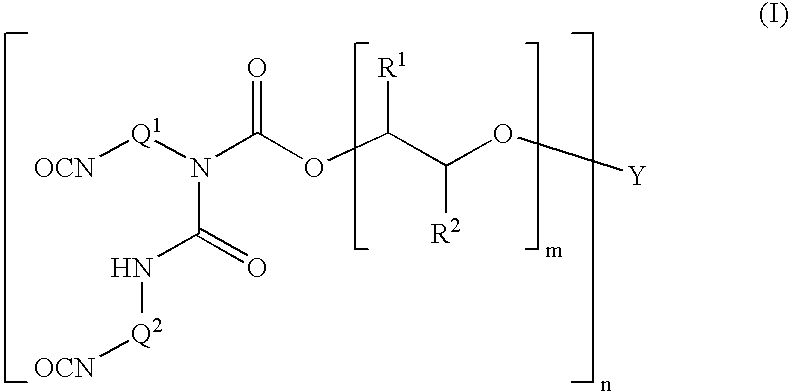Polyether allophanates stable towards discolouration
a technology of polyether allophanates and stable discolouration, which is applied in the preparation of isocyanic acid derivatives, other chemical processes, organic chemistry, etc., can solve the problems of reducing the nco content of products and a considerable increase in viscosity
- Summary
- Abstract
- Description
- Claims
- Application Information
AI Technical Summary
Benefits of technology
Problems solved by technology
Method used
Image
Examples
working examples
[0072]Unless mention is made to the contrary, all percentages should be understood as being weight percent.
[0073]The NCO contents were determined by back-titration of excess added di-n-butylamine with hydrochloric acid.
[0074]The viscosities were determined using a rotational viscometer from Haake at 23° C.
[0075]The colour number was determined in accordance with DIN EN 1557 (Hazen).
example 1
[0080]275.5 g of 1,6-hexane diisocyanate were first admixed with 120 mg of a 10% strength solution of isophthaloyl dichloride in n-butyl acetate and then the mixture was heated to 100° C. with stirring. Then, over the course of about 3 hours, 324.3 g were added of a polypropylene glycol which had been prepared by means of DMC catalysis (base-free) (amount of unsaturated groups <0.01 meq / g, molar weight 2000 g / mol, OH number 56 mg KOH / g, theoretical functionality 2) had. Thereafter the reaction mixture was heated at 100° C. until an NCO content of 20.7% was reached. At that point the temperature was lowered to 90° C. and the reaction mixture, following the addition of 50 mg of zinc(II) bis(2-ethylhexanoate), was stirred until the NCO content was 18.4%. Following the addition of 50 mg of isophthaloyl dichloride the excess 1,6-hexane diisocyanate was removed by means of thin-film distillation at 0.3 mbar and 140° C.
[0081]This gave a clear product having a Hazen colour number of 5, an N...
example 2
[0082]502.4 g of 1,6-hexane diisocyanate were heated to 100° C. with stirring. Then, over the course of about 3 hours, 297.5 g were added of a polypropylene glycol which had been obtained by means of DMC catalysis (base-free) (molar weight 1000 g / mol, OH number 112 mg KOH / g, theoretical functionality 2). The reaction mixture was subsequently heated at 100° C. until an NCO content of 28.2% was reached. At that point the temperature was lowered to 90° C. and the reaction mixture, following the addition of 70 mg of zinc(II) bis(2-ethylhexanoate), was stirred until the NCO content was 25.1%. Following the addition of 40 mg of dibutyl phosphate the excess 1,6-hexane diisocyanate was removed by means of thin-film distillation at about 0.5 mbar and 140° C.
[0083]This gave a colourless product having a Hazen colour number of 0, an NCO content of 8.95% and a viscosity of 3500 mPas (23° C.). The colour number is much lower than that of the corresponding product obtained in accordance with Comp...
PUM
| Property | Measurement | Unit |
|---|---|---|
| polydispersity | aaaaa | aaaaa |
| temperatures | aaaaa | aaaaa |
| polydispersity | aaaaa | aaaaa |
Abstract
Description
Claims
Application Information
 Login to View More
Login to View More - R&D
- Intellectual Property
- Life Sciences
- Materials
- Tech Scout
- Unparalleled Data Quality
- Higher Quality Content
- 60% Fewer Hallucinations
Browse by: Latest US Patents, China's latest patents, Technical Efficacy Thesaurus, Application Domain, Technology Topic, Popular Technical Reports.
© 2025 PatSnap. All rights reserved.Legal|Privacy policy|Modern Slavery Act Transparency Statement|Sitemap|About US| Contact US: help@patsnap.com


